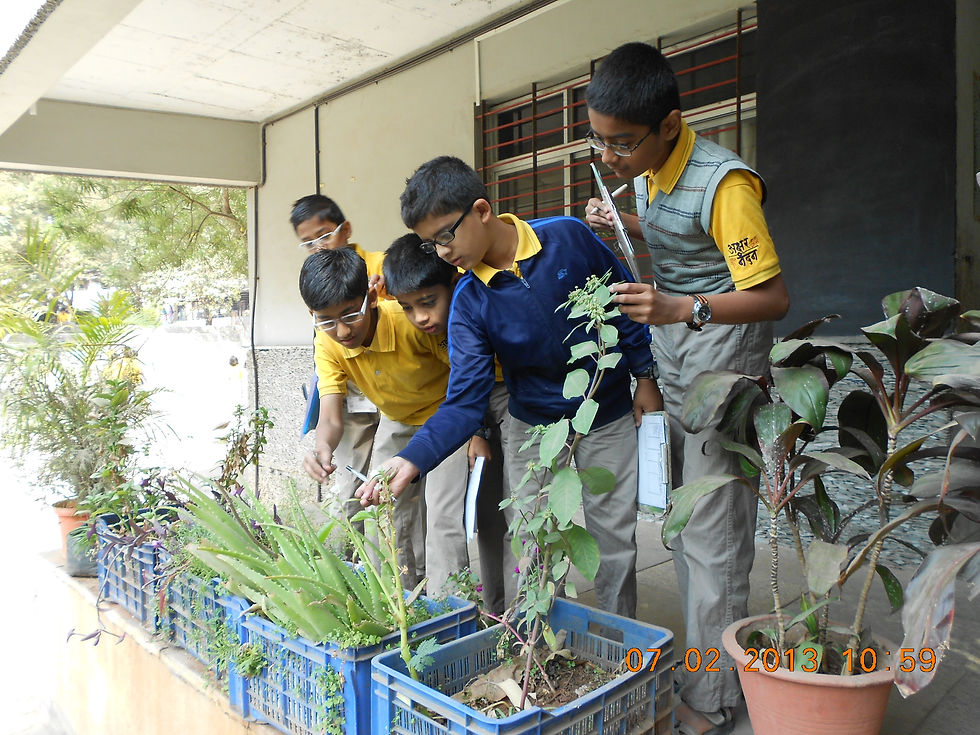Learning to heal the Earth: Part 4
- natureclassrooms
- Nov 23, 2023
- 3 min read
Updated: Nov 24, 2023
by Jayashree Ramadas and Dhanya K
Part 4: Building eco-awareness - Aksharnandan

Aksharnandan is a school in Pune which aims to integrate the classroom with the world outside, starting with the local surroundings. Environmental education translates here as 'eco-sensibility': understanding the intricate web of life and the responsibility of humans to sustain life on earth. [1] The school’s ethos and the support from the community help in achieving this goal. The school makes an effort to build sustainability into all aspects of its functioning. For instance, creative reuse and upcycling of materials is the norm. Here, parents and local businesses help by donating used paper, packaging, cloth, decorations, etc. Within the framework of the State Board curriculum, Aksharnandan School manages to include innovative activities, projects, guest interactions, and field visits. Students' interactions, whether with a Korku tribal poet, or with the waste collectors in Pune, are designed to break down social barriers.
Local language and local context

Aksharnandan strongly believes in education through the home language, taking inspiration from Rabindranath Tagore's argument that the liberation of India's mind requires a return to itself: to India's languages, cultures, and aesthetic traditions. Even practical work is simplified: for example, when a teacher asks students to bring seeds for a germination activity, they use common names and references for food grains and spices in the kitchen. Teaching children about local flora becomes easier when flowers, trees, and medicinal plants are identified by their local names. At home, parents and grandparents too can participate in these conversations.

This synergy between school education and the local context is enabled by the language. In Pune, though English remains the language of higher education and research, public discourse around nature and the environment happens mainly in the local language, Marathi. Newspapers and magazines carry articles by local experts or based on interviews with them. Love of nature also finds spontaneous expression in poetry. Besides well-known litterateurs of the past and present, some botanists and naturalists are also poets and writers.[2] Resources for environmental education are created all the time in this milieu. Most of all, as one of the teachers declared, "The people are our resource!"

Like Aksharnandan we find other modest schools in Maharashtra, with their distinctive character, rooted in their local communities, all sharing an ethos of simplicity, sustainability, and living lightly on the earth. Some known ones are the Anand Niketan schools in Wardha and Nashik, Kamala Nimbkar Bal Bhavan in Phaltan, and Srujan Anand in Kolhapur. Some of their efforts have been documented.[3, 4] Such schools would surely exist in other states. They need to become better known and highlighted.
Common medicinal plants (left) and Leaf art (right)
The way ahead: local linkages, local resources
We could promote locally relevant, environmentally aware education by strengthening the
links between the school and the community. Field trips would be not one-off events but aimed at establishing such linkages. Clusters of schools, with the help of experts, could map biodiversity within their grounds. Collecting stories and poems related to nature, documenting environmental issues and restoration efforts, creating directories of experts willing to share their knowledge... are just some of the multiple efforts that could be done.
After all, it takes a village to raise a child!
Key Takeaways
(for all 4 parts)
Effective environmental education is a result of active learning through the students' natural and social environment.
Environmental discussions are inherently problematic due to contradictions and disconnects existing between the natural and the social worlds, and the socio-economic injustices in our society.
In the ecosystem of a city, a hidden knowledge base exists that can help connect education with the students' natural and social environments. Linkages between the school and the community can be locally forged. The examples of Al Qamar Academy and Aksharnandan are cited.
Local languages, local resources and an ethos of ‘eco-sensibility’ are critical to this effort.
Resource generation is possible with cooperation between clusters of schools. Such resources may be shared and multiplied for wider use.
Image credits: Aksharnandan, Pune
References:
[1] Aksharnandan (Pune) brochure (English, Year 2000): 'Aksharnandan: An abode of joyous learning and enduring values'.
[2] A modern sampler is this Marathi poem on the Indian Laburnum, or the 'Golden Shower Tree', composed by one ecologist and recited by another: "Bahawa" by Mandar Datar, recited by Ketaki Ghate. Channel: Oikos for Ecological Services.
[3] These and other experimental schools in Maharashtra have been described in Panse, Ramesh (2018): Shikshan: Anandkshan (in Marathi). Granthali.
[4] Palshikar, Deepa and Shevade, Snigdha (2022): Anand Niketan: A Journey to Joyful and Meaningful Education. Avishkar Shikshan Sanstha, Anand Niketan.
About the Authors
Jayashree Ramadas: Research and Development in Science Education; formerly at Homi Bhabha Centre for Science Education and TIFR Hyderabad.
Dhanya K: Researcher & Science Educator formerly Teacher at Rishi Valley School.









Learning to heal the Earth starts with understanding environmental challenges and sustainable solutions. University of Arizona courses, students gain the skills needed to build a greener, healthier future.